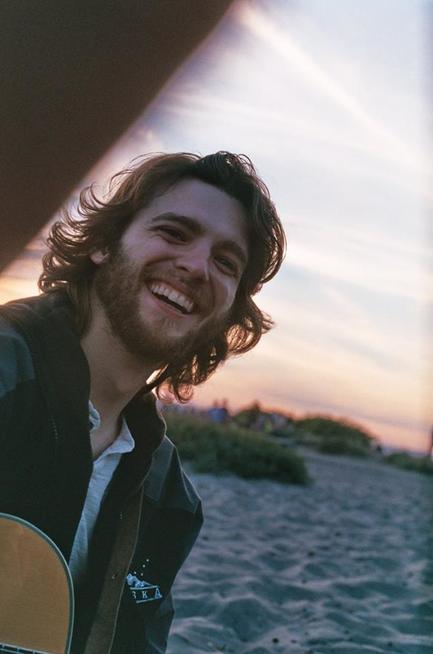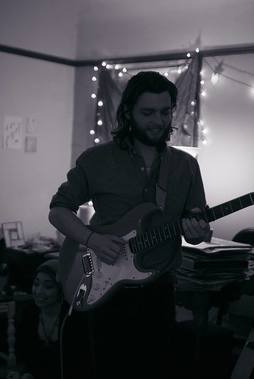
Anthony Lee Phillips Interview
Q: Can you tell us about your musical history?
A: Music has run in my family a long time, on both sides. My grandpa, my cousins, a few of my siblings, my uncle, my dad...we all play something, and most of us play anything we can get our hands on, so it's always been around me.
For me personally, I started on the flute (cause they wouldn't let me play piccolo), then I went to the alto sax, then the baritone sax. By the time I reached the guitar, music was the easiest way to express what I felt. It feels like my first language. So when I came around to the guitar, I just started pumping out tunes. I got about 100 songs finished in the first year or so, just cause I'd write it, record it and then forget the song altogether. I turn around and there are 17 songs! And there are 10 more! It was a really sweet time in my life.
Q: Your release Between Doubles had vivid imagery that was often ambiguous within the lyrics. Can you talk about the importance of lyrics to your music?
A: Texture is the first concern with my music: I want you to feel something as you're listening to it. Some tunes I want you to feel gooey, versus a song where the edges are really hard, and the melodies are angular and bumpy. So with lyrics, I pay a lot of mind to those textures. For example, a lyric from my song "Bluejay" is: "Money is not a real thing / money's something fluid it comes and goes. / Honey, fly the coop with me… / Can't you feel the air beneath your toes?" The song itself wants to float, like a lazy bird, in and out of a dream. So with those lyrics, I wanted the rhyme to sneak up, and for the lyrics to be simple, expressive and to flow into each other.
I think a lot about what I see,\ or what I hear someone saying. I usually write a riff, then I improvise a melody, then I decide on an image or a theme, or a really potent lyric, then I build the song as quickly as I can out of that.
Q: What was your creative process like when creating Between Doubles?
A: The record took 15 months to make. It started in February 2016 when I met sound engineer Sean Wheatley. I brought him a short list of about 40 songs that I'd written over the past few years, and we just started working a tune at a time. We started with “Bluejay,” which had been written just a couple of days before (it didn't change a whole lot after that first day). I brought in my favorite Seattle musicians to fill out the tracks in interesting ways, and we just experimented. When I wanted trumpet, I brought in my buddy Andrew; when I thought "what about cello?" I shot a line to my friend Justin….It was pretty chaotic actually. We recorded most of the drums last! But we just decided to have fun and let the songs tell us what needed to be done next. Sean was a great collaborator, and musician, and shreds the bass on a couple tracks.
Q: Can you tell us about your musical history?
A: Music has run in my family a long time, on both sides. My grandpa, my cousins, a few of my siblings, my uncle, my dad...we all play something, and most of us play anything we can get our hands on, so it's always been around me.
For me personally, I started on the flute (cause they wouldn't let me play piccolo), then I went to the alto sax, then the baritone sax. By the time I reached the guitar, music was the easiest way to express what I felt. It feels like my first language. So when I came around to the guitar, I just started pumping out tunes. I got about 100 songs finished in the first year or so, just cause I'd write it, record it and then forget the song altogether. I turn around and there are 17 songs! And there are 10 more! It was a really sweet time in my life.
Q: Your release Between Doubles had vivid imagery that was often ambiguous within the lyrics. Can you talk about the importance of lyrics to your music?
A: Texture is the first concern with my music: I want you to feel something as you're listening to it. Some tunes I want you to feel gooey, versus a song where the edges are really hard, and the melodies are angular and bumpy. So with lyrics, I pay a lot of mind to those textures. For example, a lyric from my song "Bluejay" is: "Money is not a real thing / money's something fluid it comes and goes. / Honey, fly the coop with me… / Can't you feel the air beneath your toes?" The song itself wants to float, like a lazy bird, in and out of a dream. So with those lyrics, I wanted the rhyme to sneak up, and for the lyrics to be simple, expressive and to flow into each other.
I think a lot about what I see,\ or what I hear someone saying. I usually write a riff, then I improvise a melody, then I decide on an image or a theme, or a really potent lyric, then I build the song as quickly as I can out of that.
Q: What was your creative process like when creating Between Doubles?
A: The record took 15 months to make. It started in February 2016 when I met sound engineer Sean Wheatley. I brought him a short list of about 40 songs that I'd written over the past few years, and we just started working a tune at a time. We started with “Bluejay,” which had been written just a couple of days before (it didn't change a whole lot after that first day). I brought in my favorite Seattle musicians to fill out the tracks in interesting ways, and we just experimented. When I wanted trumpet, I brought in my buddy Andrew; when I thought "what about cello?" I shot a line to my friend Justin….It was pretty chaotic actually. We recorded most of the drums last! But we just decided to have fun and let the songs tell us what needed to be done next. Sean was a great collaborator, and musician, and shreds the bass on a couple tracks.

Q: The album was very diverse in terms of energy and momentum. How does that play into the sequential order of the songs and the journey they take you on? How much thought is put into that for you?
A: Yes! One of my big semi-local influences is Noah Gundersen, and his old band The Courage released a record called Fearful Bones which was a huge influence on me. It really showed me that how you set up the song list of an album can change the way you hear those songs. I spent a lot of time making sure that each transition had some harmonic movement, and that there was variation from song to song. In the mastering session, Ed Brooks and I really tried to make it feel like each song was flowing into the next one, like an indie-rock suite.
From a conceptual perspective, song order was also important: the first half of the album is about falling out of love, "Lonewolf" sits in the middle, and the second half of the album is about falling back in love again. The first song and the last song are both in the same key, so it creates the sensation of a continuum when listened to on repeat.
Q: Do you feel that there are reoccurring concepts that you visit on the album?
A: Trust and doubt are in a lot of my music. I'm obsessed with love (I think most people are), but I think that love without trust is totally doomed, and that shows up in songs like "Mr. Blithe," "Fade" and "Reasons."
Q: What musical plans do you have for the remainder of 2017 and beyond?
A: I'm moving to New York City in September, and the plan is to have some adventures. There's always more to learn!
A: Yes! One of my big semi-local influences is Noah Gundersen, and his old band The Courage released a record called Fearful Bones which was a huge influence on me. It really showed me that how you set up the song list of an album can change the way you hear those songs. I spent a lot of time making sure that each transition had some harmonic movement, and that there was variation from song to song. In the mastering session, Ed Brooks and I really tried to make it feel like each song was flowing into the next one, like an indie-rock suite.
From a conceptual perspective, song order was also important: the first half of the album is about falling out of love, "Lonewolf" sits in the middle, and the second half of the album is about falling back in love again. The first song and the last song are both in the same key, so it creates the sensation of a continuum when listened to on repeat.
Q: Do you feel that there are reoccurring concepts that you visit on the album?
A: Trust and doubt are in a lot of my music. I'm obsessed with love (I think most people are), but I think that love without trust is totally doomed, and that shows up in songs like "Mr. Blithe," "Fade" and "Reasons."
Q: What musical plans do you have for the remainder of 2017 and beyond?
A: I'm moving to New York City in September, and the plan is to have some adventures. There's always more to learn!
